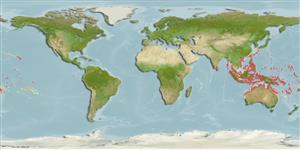Environment: milieu / climate zone / depth range / distribution range
Ökologie
seewasser; brackwasser riff-verbunden; tiefenbereich 0 - 15 m (Ref. 1602). Tropical; 32°N - 31°S, 77°E - 130°W
Indo-Pacific: Sri Lanka to the Tuamoto Islands, north to southern Japan, south to the Great Barrier Reef; Palau (Belau) to the eastern Caroline Islands in Micronesia.
Size / Gewicht / Alter
Maturity: Lm ? range ? - ? cm
Max length : 18.0 cm TL Männchen/unbestimmt; (Ref. 48636); common length : 15.0 cm TL Männchen/unbestimmt; (Ref. 48636)
Rückenflossenstacheln (insgesamt): 12 - 13; Rückenflossenweichstrahlen (insgesamt): 21-23; Afterflossenstacheln 3; Afterflossenweichstrahlen: 18 - 20. Body color is yellow with cross-hatched pattern on the sides. A dark black spot is sometimes present under the spinous portion of the dorsal fin. A black bar runs across the eye. The dorsal, anal and caudal fins have a dark stripe the position of which varies with age (Ref. 4855). Snout length 2.1-2.6 in HL. Body depth 1.4-1.8 in SL (Ref. 90102).
An uncommon species found in areas of rich coral growth of lagoon and protected reef flats and seaward reefs (Ref. 9710). Often in pairs (Ref. 9710, 48636). Feed on sea anemones, polychaetes, and octocorallian and scleractinian coral polyps. Oviparous (Ref. 205). Form pairs during breeding (Ref. 205). In captivity, this species should be fed algae stones and the so-called 'feeding stones' which are prepared by spreading the food pulp over the stone. Minimum depth reported taken from Ref. 128797.
Life cycle and mating behavior
Geschlechtsreife | Fortpflanzung | Ablaichen | Eier | Fecundity | Larven
Distinct pairing (Ref. 205).
Myers, R.F., 1991. Micronesian reef fishes. Second Ed. Coral Graphics, Barrigada, Guam. 298 p. (Ref. 1602)
IUCN Rote Liste Status (Ref. 130435)
Bedrohung für Menschen
Harmless
Nutzung durch Menschen
Fischereien: weniger kommerziell; Aquarium: Kommerziell
Mehr Information
ReferenzenAquakulturAquakultur ProfilZuchtlinienGenetikElectrophoresesVererbbarkeitKrankheitenVerarbeitungNutrientsMass conversion
Tools
Zusatzinformationen
Download XML
Internet Quellen
Estimates based on models
Preferred temperature (Ref.
123201): 25.1 - 29.3, mean 28.6 °C (based on 2681 cells).
Phylogenetic diversity index (Ref.
82804): PD
50 = 0.5000 [Uniqueness, from 0.5 = low to 2.0 = high].
Bayesian length-weight: a=0.02291 (0.01133 - 0.04632), b=3.00 (2.83 - 3.17), in cm total length, based on LWR estimates for this Genus-body shape (Ref.
93245).
Trophic level (Ref.
69278): 4.3 ±0.0 se; based on diet studies.
Widerstandsfähigkeit (Ref.
120179): hoch, Verdopplung der Population dauert weniger als 15 Monate. (Preliminary K or Fecundity.).
Fishing Vulnerability (Ref.
59153): Low vulnerability (10 of 100).
Nutrients (Ref.
124155): Calcium = 88.7 [43.0, 172.9] mg/100g; Iron = 0.725 [0.395, 1.299] mg/100g; Protein = 19.4 [18.2, 20.5] %; Omega3 = 0.133 [0.075, 0.238] g/100g; Selenium = 24 [12, 50] μg/100g; VitaminA = 58 [15, 228] μg/100g; Zinc = 1.33 [0.84, 2.00] mg/100g (wet weight);
